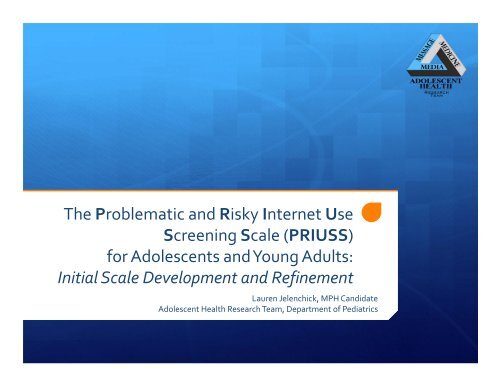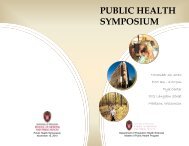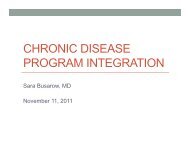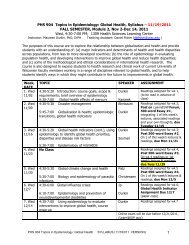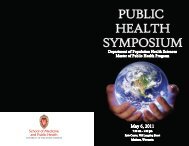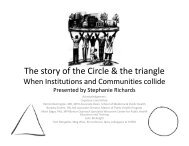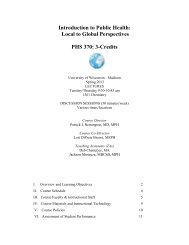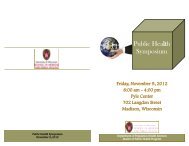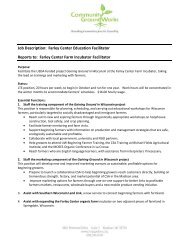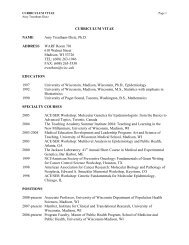The Problematic and Risky Internet Use Screening Scale (PRIUSS ...
The Problematic and Risky Internet Use Screening Scale (PRIUSS ...
The Problematic and Risky Internet Use Screening Scale (PRIUSS ...
Create successful ePaper yourself
Turn your PDF publications into a flip-book with our unique Google optimized e-Paper software.
<strong>The</strong> <strong>Problematic</strong> <strong>and</strong> <strong>Risky</strong> <strong>Internet</strong> <strong>Use</strong><br />
<strong>Screening</strong> <strong>Scale</strong> (<strong>PRIUSS</strong>)<br />
for Adolescents <strong>and</strong> Young Adults:<br />
Initial <strong>Scale</strong> Development <strong>and</strong> Refinement<br />
Lauren Jelenchick, MPH C<strong>and</strong>idate<br />
Adolescent Health Research Team, Department of Pediatrics
Background<br />
<strong>Internet</strong> use is nearly ubiquitous <strong>and</strong><br />
increasingly influential in the lives of<br />
adolescents <strong>and</strong> young adults<br />
95% are online<br />
75% own a computer or laptop<br />
Average <strong>Internet</strong> use of 2 hours a day<br />
80% use a social networking site
Background<br />
Overuse of the <strong>Internet</strong> linked with:<br />
Sleep disorders<br />
Depression <strong>and</strong> anxiety<br />
Drug <strong>and</strong> alcohol use<br />
Poor academic performance<br />
Poor social adjustment
Background<br />
<strong>Problematic</strong> <strong>Internet</strong> <strong>Use</strong> (PIU)<br />
Overuse of the <strong>Internet</strong> leading to adverse health <strong>and</strong> life<br />
consequences<br />
May affect between 4‐15% of adolescents <strong>and</strong><br />
young adults<br />
Emerging condition Lacking available<br />
intervention capabilities<br />
<strong>Screening</strong> instruments<br />
Prevention strategies
Project purpose<br />
Develop <strong>and</strong> validate a theory‐based screening<br />
instrument for PIU for use with adolescents <strong>and</strong><br />
young adults in research <strong>and</strong> clinical settings<br />
Objectives<br />
1 Define a guiding theoretical model<br />
2 Develop an item pool<br />
3 Reduce items to a reliable screening instrument<br />
4 Survey health providers for feedback on use of the scale
Methods<br />
PIU <strong>The</strong>oretical Framework<br />
Psychological<br />
Risk Factors<br />
Physical<br />
Impairment<br />
<strong>Risky</strong> <strong>Internet</strong><br />
<strong>Use</strong><br />
Emotional<br />
Impairment<br />
<strong>Problematic</strong><br />
<strong>Internet</strong> <strong>Use</strong><br />
Impulsive<br />
<strong>Internet</strong> <strong>Use</strong><br />
Social/Functio<br />
nal<br />
Impairment<br />
<strong>Internet</strong> <strong>Use</strong><br />
Dependency
Methods<br />
Item Pool Development<br />
List of symptoms <strong>and</strong> characteristics of PIU<br />
developed by adolescents/young adults <strong>and</strong><br />
health providers<br />
75 total items<br />
Review of the literature for existing<br />
measurements<br />
5 additional items<br />
Reviewed by a group of adolescents/young<br />
adults for clarity/comprehension
Methods<br />
Item Reduction: Data Collection<br />
716 students recruited from UW‐Madison <strong>and</strong><br />
UW‐Milwaukee<br />
Completed an online survey<br />
$5 gift card for participating
Methods<br />
Item Reduction: Data Analysis<br />
Exploratory factor analysis<br />
<br />
<br />
Reduce total number of items<br />
Determine number of factors<br />
Confirmatory factor analysis<br />
<br />
Assess the overall fit of the model<br />
Examine associations with self‐reported<br />
<strong>Internet</strong> use<br />
<br />
Construct validity
Results<br />
Exploratory Factor Analysis<br />
Figure 1. Scree plot of exploratory factor<br />
analysis<br />
Table 1. Eigenvalues <strong>and</strong> variance<br />
explained by top four factors extracted in<br />
the exploratory factor analysis<br />
Number of<br />
factors Eigenvalue<br />
Proportion of<br />
variance explained<br />
Cumulative proportion of<br />
variance explained<br />
1 14.5 79.0% 79.0%<br />
2 1.6 8.6% 87.6%<br />
3 1.2 6.8% 96.2%<br />
4 0.6 3.2% 97.6%<br />
1<br />
Comprised of items with an item-scale correlation ≥ 0.60
Results<br />
Confirmatory Factor Analysis<br />
Table 2. Findings from the<br />
Confirmatory Factor<br />
Analysis of the Three<br />
Factor Model in the<br />
Development Subsample<br />
Item<br />
Abbreviated text<br />
Factor 1 – Social Consequences<br />
Factor<br />
Loading (SE)<br />
18 Problems with communicating face to face 0.79 (0.039)<br />
19 Experience increased social anxiety 0.79 (0.039)<br />
34 Fail to create real-life relationships 0.78 (0.039)<br />
79 Offline relationships suffer 0.78 (0.039)<br />
74 Choose to socialize online instead of in-person 0.74 (0.040)<br />
52 Skip out on social events 0.73 (0.040)<br />
Cronbach’s alpha 0.89<br />
Factor 2 – Emotional Consequences<br />
44 Feel anxious when away from internet 0.88 (0.036)<br />
25 Feelirritated when not using the internet 0.86 (0.036)<br />
38 Experience feelings of withdrawal when not using the 0.82 (0.037)<br />
internet<br />
13 Feel angry when away from the internet 0.75 (0.039)<br />
22 Feelvulnerable when the internet isn't available 0.73 (0.039)<br />
Cronbach’s alpha 0.90<br />
Model fit statistics<br />
GFI: 0.92<br />
RMSEA: 0.06<br />
Factor 3 – <strong>Risky</strong> <strong>and</strong> Impulsive <strong>Internet</strong> <strong>Use</strong><br />
55 Allow time on the internet to negatively affect your school 0.77 (0.039)<br />
performance<br />
60 Lose motivation to do other things that need to get done 0.76 (0.039)<br />
40 Neglect responsibilities 0.75 (0.040)<br />
32 Avoid other activities in order to stay online 0.72 (0.040)<br />
16 Put internet use in front of important, everyday activities 0.70 (0.041)<br />
70 Lose sleep due to nighttime internet use 0.65 (0.042)<br />
61 <strong>Use</strong> the internet excessively 0.64 (0.042)<br />
Cronbach’s alpha 0.88
Results<br />
Construct Validity<br />
Table 3. Spearman’s rank correlations<br />
coefficients between daily <strong>Internet</strong> use duration<br />
<strong>and</strong> <strong>PRIUSS</strong> scores<br />
Overall Score<br />
Social<br />
Consequences<br />
Subscale Scores<br />
Emotional<br />
Consequences<br />
<strong>Risky</strong>/Impulsive<br />
<strong>Internet</strong> <strong>Use</strong><br />
Self-reported<br />
<strong>Internet</strong> use 0.28 (p
PROBLEMATIC AND RISKY INTERNET USE SCREENING SCALE (<strong>PRIUSS</strong>)<br />
Please answer the questions below based on how you have felt <strong>and</strong> conducted yourself over<br />
the past 6 months. Please do your best to interpret these questions as they apply to your own<br />
experiences <strong>and</strong> feelings.<br />
Place an in the box which best describes your answer.<br />
How often …<br />
Never<br />
Rarely<br />
Sometimes<br />
Often<br />
Very Often<br />
1. do you choose to socialize online instead of in-person? 0 1 2 3 4<br />
2. do you have problems with face to face communication due to<br />
your internet use?<br />
3. do you experience increased social anxiety due to your internet<br />
use?<br />
4. do you fail to create real-life relationships because of the<br />
internet?<br />
0 1 2 3 4<br />
0 1 2 3 4<br />
0 1 2 3 4<br />
5. do you skip out on social events to spend time online? 0 1 2 3 4<br />
6. do your offline relationships suffer due to your internet use? 0 1 2 3 4<br />
7. do you feel irritated when you’re not able to use the internet? 0 1 2 3 4<br />
8. do you feel angry because you are away from the internet? 0 1 2 3 4<br />
9. do you feel anxious because you are away from the internet? 0 1 2 3 4<br />
10. do you feel vulnerable when the internet isn't available? 0 1 2 3 4<br />
11. do you experience feelings of withdrawal from not using the<br />
internet?<br />
0 1 2 3 4<br />
12. do you put internet use in front of important, everyday activities? 0 1 2 3 4<br />
13. do you avoid other activities in order to stay online? 0 1 2 3 4<br />
14. do you neglect your responsibilities because of the internet? 0 1 2 3 4<br />
15. do you lose motivation to do other things that need to get done<br />
because of the internet?<br />
0 1 2 3 4<br />
16. do you lose sleep due to nighttime internet use? 0 1 2 3 4<br />
17. does time on the internet negatively affect your school<br />
performance?<br />
0 1 2 3 4<br />
18. do you use the internet excessively? 0 1 2 3 4<br />
Add columns + + + + =<br />
Total score
Results<br />
Health Provider Feedback<br />
I think that in a physical, when someone is<br />
coming in for guidance on their heath, [the<br />
<strong>PRIUSS</strong>] could slip in quite easily, if the clinician is<br />
aware of the issues we are talking about
Results<br />
Health Provider Feedback<br />
One interesting thought about this is that if you<br />
gave it to the majority of parents <strong>and</strong> asked them<br />
to fill it out, they may have the same problematic<br />
internet use as their kids. So, it’d be interesting if<br />
you gave it to parents <strong>and</strong> children, if you’re even<br />
gearing at the children
Results<br />
Health Provider Feedback<br />
It’s a hard thing, unlike smoking or drugs or<br />
alcohol, you can’t say, “You can’t do it at all.”<br />
<strong>The</strong>re’s never that option which is difficult.
Conclusions<br />
<strong>The</strong> <strong>PRIUSS</strong> showed strong reliability <strong>and</strong><br />
preliminary validity<br />
Built on a strong theoretical foundation <br />
construct validity<br />
Promising tool for screening <strong>and</strong> prevention<br />
efforts
Limitations<br />
Generalizability<br />
“Healthy‐sample” approach<br />
Predicative validity
Next steps …<br />
Validation study<br />
Apply scale to other populations<br />
Younger adolescents<br />
At‐risk groups<br />
Pilot study assessing PIU <strong>and</strong> alcohol/drug us
Acknowledgments<br />
Adviser: Megan Moreno<br />
Capstone Committee<br />
Dimitri Christakis<br />
Rich Brown<br />
Meghan Benson<br />
Adolescent Health Research Team<br />
Angela Davis<br />
Jaimee Goldish<br />
Jens Eickhoff, Chong Zhang
Questions?


